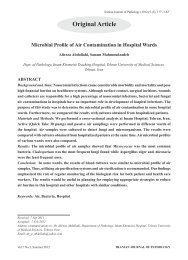World Health Organization Classification of Tumours Pathology and ...
World Health Organization Classification of Tumours Pathology and ...
World Health Organization Classification of Tumours Pathology and ...
You also want an ePaper? Increase the reach of your titles
YUMPU automatically turns print PDFs into web optimized ePapers that Google loves.
acinar pattern. The alveolar <strong>and</strong> acinarstructures may dilate, producing microcystic<strong>and</strong> macrocystic patterns.Infrequently, clear cell renal cell carcinomahas a distinct tubular pattern <strong>and</strong>rarely a pseudopapillary architecture isfocally present.The cytoplasm is commonly filled withlipids <strong>and</strong> glycogen, which are dissolvedin routine histologic processing, creatinga clear cytoplasm surrounded by a distinctcell membrane. Many tumours containminority populations <strong>of</strong> cells witheosinophilic cytoplasm; this is particularlycommon in high grade tumours <strong>and</strong>adjacent to areas with necrosis or haemorrhage.In well preserved preparations, the nucleitend to be round <strong>and</strong> uniform with finelygranular, evenly distributed chromatin.Depending upon the grade, nucleoli maybe inconspicuous, small, or large <strong>and</strong>prominent. Very large nuclei lackingnucleoli or bizarre nuclei may occasionallyoccur. A host <strong>of</strong> unusual histologicfindings are described in clear cell renalcell carcinoma. Sarcomatoid changeoccurs in 5% <strong>of</strong> tumours <strong>and</strong> is associatedwith worse prognosis. Some tumourshave central areas <strong>of</strong> fibromyxoid stroma,areas <strong>of</strong> calcification or ossification{991}. Most clear cell RCCs have littleassociated inflammatory response; infrequently,an intense lymphocytic or neutrophilicinfiltrate is present.Immunopr<strong>of</strong>ileClear cell RCCs frequently react withantibodies to brush border antigens, lowmolecular weight cytokeratins, CK8,CK18, CK19, AE1, Cam 5.2 <strong>and</strong> vimentin{1675,2086,2818,2880}. High molecularweight cytokeratins, including CK14{464}, <strong>and</strong> 34βE12 are rarely detected.The majority <strong>of</strong> clear cell RCCs reactpositively for renal cell carcinoma marker{1675}, CD10 {140} <strong>and</strong> epithelial membraneantigen {776}. MUCΙ <strong>and</strong> MUC3are consistently expressed {1479}.GradingNuclear grade, after stage, is the mostimportant prognostic feature <strong>of</strong> clearcell renal cell carcinoma {441,764,815,949,2433,2473,2940}. The prognosticvalue <strong>of</strong> nuclear grade has beenvalidated in numerous studies over thepast 8 decades. Both 4-tiered <strong>and</strong> 3-tiered grading systems are in widespreaduse. The 4-tiered nuclear gradingsystem {815} is as follows: Using the 10xobjective, grade 1 cells have smallhyperchromatic nuclei (resemblingmature lymphocytes) with no visiblenucleoli <strong>and</strong> little detail in the chromatin.Grade 2 cells have finely granular "open"chromatin but inconspicuous nucleoli atthis magnification. For nuclear grade 3,the nucleoli must be easily unequivocallyrecognizable with the 10x objective.Nuclear grade 4 is characterizedby nuclear pleomorphism, hyperchromasia<strong>and</strong> single to multiple macronucleoli.Grade is assigned based onthe highest grade present. Scatteredcells may be discounted but if severalcells within a single high power focushave high grade characteristics, thenthe tumour should be graded accordingly.Genetic susceptibilityClear cell renal cell carcinoma constitutesa typical manifestation <strong>of</strong> vonHippel-Lindau disease (VHL) but mayalso occur in other familial renal cell cancersyndromes.Somatic geneticsAlthough most clear cell RCCs are notrelated to von Hippel Lindau disease, 3pdeletions have been described in thevast majority <strong>of</strong> sporadic clear cell renalcell carcinoma by conventional cytogenetic,FISH, LOH <strong>and</strong> CGH analyses{1372,1754,1760,1786,2109,2614,2690,2691,2723,2925}. At least 3 separateregions on chromosome 3p have beenimplicated by LOH studies as relevant forsporadic renal cell carcinoma: one coincidentwith the von Hippel-Lindau (VHL)disease gene locus at 3p25-26{1445,2400}, one at 3p21-22 {2689} <strong>and</strong>one at 3p13-14 {2721}, which includesthe chromosomal translocation point infamilial human renal cell carcinoma.These data suggest involvement <strong>of</strong> multipleloci on chromosome 3 in renal cancerdevelopment {474,2686}.Mutations <strong>of</strong> the VHL gene have beendescribed in 34-56% <strong>of</strong> sporadic clearcell RCC {307,792,897,2342,2400,2810}.DNA methylation was observed in 19% <strong>of</strong>clear cell renal cell carcinomas {1082}.Therefore, somatic inactivation <strong>of</strong> theVHL gene may occur by allelic deletion,mutation, or epigenetic silencing in 70%or more {897,1082,1445,2342}. Thesedata suggest that the VHL gene is themost likely c<strong>and</strong>idate for a tumour suppressorgene in sporadic clear cell RCC.ABFig. 1.18 A VHL, renal carcinoma. Note clear cells <strong>and</strong> cysts. B Clear cell renal cell carcinoma. Typical alveolar arrangement <strong>of</strong> cells.24 <strong>Tumours</strong> <strong>of</strong> the kidney



